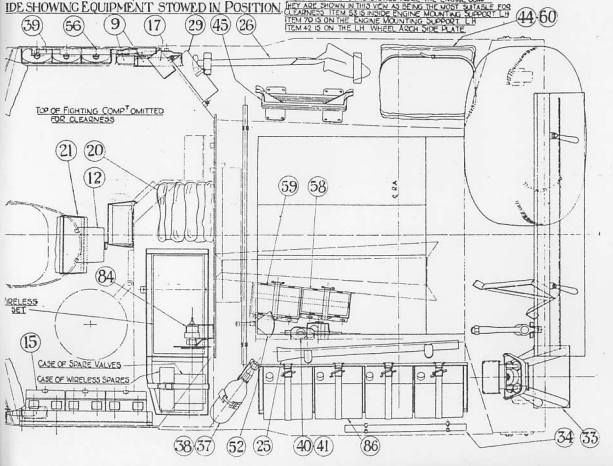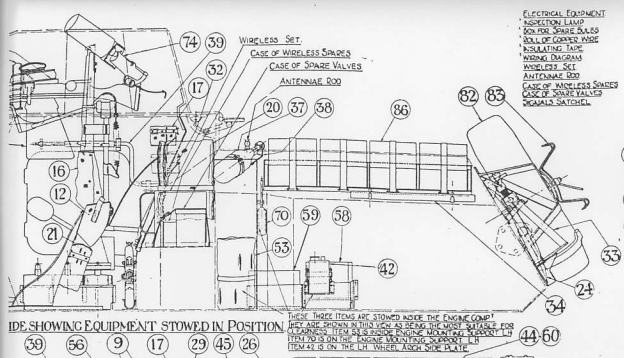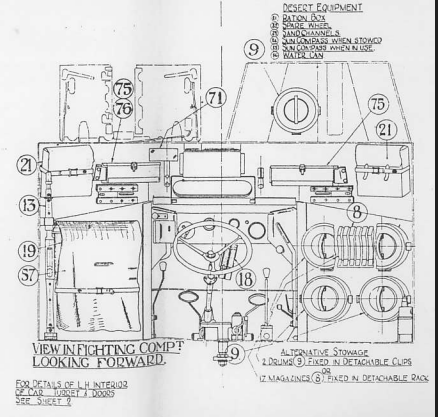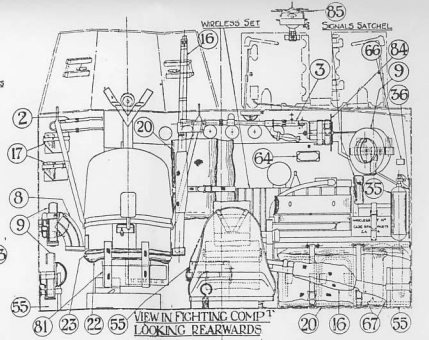Boom
Bren
Other Examples
Pixie @ 2024
Complete Equipment Stowage
External Stowage Historical Notes on the Morris Light Reconnaissance Car
Royal Engineers
Royal Air Force
Free Polish Army
Free Czech Army
US ARMY Air Force
From my time re-enacting the Scottish 15th Reconnaissance unit in NE Europe on 1944, there was an urge for the members to have one of every type of vehicle ever issued to the unit. One of the more rare and obscure vehicles is the Morris LRC. Reconnaissance vehicles, like tanks were making leaps and bounds in techniques and technology - unfortunately for the LRC, by the time it had finished development it was underpowered and under armoured for front line use. It was still issued to units and often filled their second line - there are photos of LRCs in columns in France shortly after D-Day. They persisted throughout the war and covered a lot of miles..
One of the more effective uses of this model was as an airfield guard for the RAF. Postwar what was left of them was left in yards and they were sold as surplus or scrapped.


Some (like pixie) survived for a while as an improvised farm vehicle (typically armour is cut away to provide better field of vision for the fields). Unusually this one was rescued from the field (after it finally broke) by the movie Industry - it became a movie prop for "The Battle of Britain". For this, the original turret was rescued along with it and the cab armour was hastily recreated - there seems to have been a change in plan as there is evidence of hinges being developed for doors and hatches - but then they were just welded into place. Part of its rescue and move to the US also featured laying on its side with smoke billowing out of it at a private location in the UK for WW2 events. Its been in the ArtioZen barn for about 5 years now, most of the equipment to festoon it has been collected - now its time to start restoring bits of it - especially those that are supported by our friends and our own product ventures.
Boom
I first met Boom, the Boys Anti-Tank rifle about 12 years ago as the center piece of the Seneca Arms display in the store near Green Lane - it had been there for years. John graciously offered to sell it to a local British reenacting unit to give it exercise and exposure to the public. I got the call and within a couple of hours I was taking home the largest caliber bolt action rifle that you can legally own and transfer as a PA resident in good standing.

Boom was actually commissioned in .5o BMG by the Finish Army from BSA in the later 1930's and is an excellent example of the type. On the Morris there is a slot in the front left commanders hatch (also the rear) for the Boys to mount and provision for bags of ammunition and cleaning equipment. Fun facts - The Boys was designed by "Captain" Boys - he was mad... (he wasn't actually a Captain). The doctrine for firing is to be kneeling in prepared position / dugout (or seated in a vehicle or similar mount to fire) - and not prone - your torso has to rock back on your pelvis under recoil. The mk2 Boys round has a tungsten penetrator core and will pierce 1..5" or armour under the right conditions (distance / incidence of hit). Carrying a Boys anywhere is very demotivating to the troops - having one firing on the flanks of your unit is very motivating to the troops.
Bren
The turret armament was a Bren LMG which had 100 round magazines - with extra storage positions on the inner hull for more. I have had a gas BREN built (oxy / propane) that sounds like a machine gun on full auto - but only produces noise and a little flash (but not so much for anybody to need ear protection). There are plenty of spaces and places to stow the tanks and gas lines in the turret.
Other Examples
There seems to be 11 examples remaining intact around the world of the 2200 or so built. Pixie is the second example in the US - a running, fully equipped example is privately owned in Florida. 2 more have been restored from salvaged hulks in the UK and are in private hands.
The other 3 are in museums around Europe, IMA, The Tank Museum and possibly one in Cyprus / Malta.
Pixie @ 2024
Pixie is probably at the utmost point of disassembly - engine and gearbox out along with radiator and other engine bay components. The front upper hull plate over the drivers legs were cut off by the farmer. This allows excellent access to rebuild the controls and driver compartment from the outside / top. I hope to replace these plates with bolt on / removable versions (disguised where the wings / fenders mount).
Complete Equipment Schedule

External Stowage
I have collected a good deal of the Complete Equipment Schedule. The pioneer kit (full size pick axe and spade) has been selected and tested on the remaining hull cleats I have sourced two Pyrene fire extinguishers and brackets (I may switch the internal one for a disguised modern example - I have the paint color and reproduction sticker for this in the website store (links below). With the latest partnership development with Mifflinburg Body, the external can rack can have a complement of 2 gallon cans (for petrol) applied and its construction repaired to latch them in - also now in the online store!
Historical Notes on the Morris Light Reconnaissance Car

With the loss of most of their tactical equipment in the withdrawal from Dunkirk, the British Army needed armoured cars for field reconnaissance. Morris Commercial answered the call for bids with their design for a lightweight armoured car with an anti-tank gun, machine gun and a crew of three. With little oversight from the personnel of the armoured branch, a quantity was initially ordered and issued to infantry reconnaissance elements.

The initial version (MK1) was a 4x2 design with a monocoque hull upon a suspension and drive train drawn from Morris Commercial’s truck line. It was for an armoured vehicle, light at 3.7 tons, had very high ground clearance and could reach speeds in excess of 50 MPH. Its armour was reasonably protective against small arms fire while its anti-tank gun could penetrate the armour of like class vehicles (the German Sdz. 222 for example). Morris Commercial had delivered a vehicle that could approach enemy formations better than most in that it was small, capable of off-road movement, quiet and speedy.

It was adequate for what it was designed for . . . a light armoured scout car. For those that would like a comparison the reader might think of it as an armed and armoured Jeep.
The Morris Light Armoured Car (LRC) did have its drawbacks which became increasingly apparent as it was used in service. It lacked any substantive storage space for any crew equipment, more than a few days of rations, and any routine spares. Its main armament (Boys .55 cal. anti-tank rifle) was a single shot bolt action rifle when most vehicles (even of this class) were being armed with automatic

armour piercing weapons. Its armour was adequate against many infantry weapons in 1941 but by 1943 it was increasingly vulnerable. Almost any tank or anti-tank gun would handily overcome its meager armour. It was not a vehicle to sit and duel, or a prolonged combat with any force allowing a heavier weapon to be brought to bear. Perhaps most importantly, it was often misused in the field. Instead of utilizing its ability to move quickly and stealthily, it was allowed to be drawn, even applied, into offensive situations that it was ill suited for.
When the Infantry Reconnaissance units were converted into the Reconnaissance Corps (1943 under the Armoured Services), it was found inadequate compared with the heavier designs the RAC already had. Accordingly, it was replaced by the Humber and Daimler cars in reconnaissance regiments. There had been a shift in expectations for what an Armoured Car would do. Now, the armoured car was expected to be able to penetrate more deeply and directly with the enemy. They were expected to be able to engage German tanks to a limited degree. This is beyond what the Morris LRC was designed for.

Morris Light Reconnaissance Cars (Mk1s) awaiting delivery from factory? Note the canvas covers over the upper hull, which had a designated storage area in the crew area, affixed by straps and loops. Note there are no fittings for carriage of supplies or tool holders on the rear deck area.
During its time of production, its shortcomings were addressed by making the Morris LRC (MK 2), a 4x4 allowing it to traverse off-road obstacles with even greater ease. Coupled with its very high ground clearance, small size and light weight it managed to go in places that many vehicles could not. For added crew safety small improvements to armour plating thickness were made and as they became available, the addition of a wireless set which in a tactical sense became its most important feature as a scout vehicle.

One of the most fascinating Morris LRC photos to study. The road is in wretched condition, the trees are strewn with commo wire looking like decorated Christmas Trees. The Morris is passing a British or perhaps Canadian Paratrooper. The canvas cover is affixed to the lower hull but not the turret and the rear deck is covered with gear and equipment. The crew has done their best to make the most out of their little car, trying to keep warm and dry as best they can while still leaving the Bren ready to use.
Over 2000 Morris LRCs were made and production continued until March of 1945. The other light reconnaissance car of the British Army, the Humber, had a only a slightly higher production number at about 2400. For a vehicle that was "obsolescent" by 1943, why did it continue to remain in service much less continue to be produced? The answer lies in the evolving role it was utilized. Where there were inadequate supplies of up-to-date equipment it continued to be issued to infantry reconnaissance elements (Free Polish and Czech armies), where an armoured scout car was needed to quietly explore and protect its crew from surprise small arms fire it found another lease on life (Royal Engineers) and leaving Army service, it was utilized by the RAF regiment in protecting airbases. It even found use in a “Reverse Loan Lease” arrangement supplying Morris LRCs to the USAAF for similar airfield perimeter security operations.
Royal Engineers: the small Morris LRC was sometimes referred to as a Morrisette in contemporary accounts and was seemingly used by Royal Engineer recce teams.




Relating an incident where “officer” patrols were sent out we find this account in the regimental history of the 15 Recce: (4 Nov 44 Holland) “Meanwhile the advance down the road from Liesel to Meijel continued slowly with hard fighting, in which the infantry were supported by tanks of the 6th Guards Armoured Brigade and patrols from (15th Recce, ed.) C and B Squadrons. Some of the patrols which the regiment supplied were officer liaison patrols with infantry battalions. These gave the battalion commander an up-to-date summary of the situation on his flanks, as well as affording an extra link with his brigade headquarters and with his forward companies when armoured cars were working with them. One battalion commander issued an urgent set of orders to his companies by this means after his own communications had broken down. The armoured cars advancing down the Liesel-Meijel road were nearly always under fire, partly from 75 mm guns on the east bank of the Deurne canal. From Heusden, C Squadron patrolled down the Asten-Meijel road, which was mined and cratered, and Sgt P. R. Dobson has written of the 9 Troop patrol on which Lieut Royle and an R.E. officer measured a large crater under shell fire The road to Meijel was suicide. Everybody knew that. It was dead straight for the first mile beyond the infantry positions. Then it bent slightly to the right, and continued straight for another mile, finally disappearing into some trees just outside the village. It ran across open peat bogs and marshes and was banked up several feet above ground level. We could read all that from the map, and when we came into the open to the first stretch it was no better than we expected. We were hoping to meet a crater, and eventually we did, but not until we were within a couple of hundred yards of the village. By then we had already pulled three strings of Teller mines off the road, and we had seen many Germans milling about in a wood a thousand yards behind and to the right of us. But if they had been able to get across the marsh they would not have attempted it; they were far too busy with someone else. In addition to the leading patrol we had Lieut Royle in his heavy car and an R.E. officer in a Morrisette. It was obvious that we could not pass the crater so we turned the cars while the two officers went up and gathered information about it. Then, after we had done all this and sent the information back, a sniper fired from the left. He was a bad sniper, for he completely missed four of us standing in a bunch, but when his big brothers joined in they showed him a thing or two. They evidently had four 88s in the village, and, although firing indirectly, they had the road pinpointed all the way. The Morrisette was at a farmhouse half a mile away, while the second heavy car was another four hundred yards behind us. As I dived into my car, I saw that the R.E. officer had been hit, but he managed to jump on Lofty Dullaway's car, and I held my door open for Lieut. Royle, who was in the ditch. I thought he would get on the other car, so we started off, passing the second heavy, and stopped at the farm, where we put the wounded officer on the Morrisette. We had been followed all the way by shell fire, and while turning the Engineer's car—a tricky operation because of the thickly mined verges—Lofty was hit in the leg. Then we discovered that Lieut. Royle had not been on either car. L/Cpl Songhurst started to move up to find him, but was immediately pinpointed, and Bill Thomas had to do a very hasty and tricky bit of backing. Finally, we got the three cars together at the farmhouse, and were just arranging for a party to go up to the crater on foot when a familiar voice hailed us from the ditch. It was Lieut. Royle, safe, sound and soaking; he had crawled about six hundred yards to us. I never knew why he did not come back on the cars, but I strongly suspect that he stayed to locate the guns that were firing at us. For that action alone he deserved the M.C. which he was awarded soon after (Kemsley, K., Riesco, M.R., Chamberlin, T. (2011). Scottish lion on patrol. Pen & Sword Military, Barnsley. 156-157)

Royal Engineers in Morris LRC guarding approach to Aunay-Sur-Odon whilst
the town is being cleared and bulldozed by other elements of the RE. Scroll to 1:22


Morris LRC Operation Charnwood 9 July 1944 Road to Caen Guarding the approach to a Royal Engineer Work Party. IWM A70 75-4
As you read older reference resources you may still find out dated statements about the "Recce Regiments did not use the Morris LRC after the Recce Rgts were taken in the RAC. " Here is a "Recce Marked" example in France in 1944 after the Normandy Landings.

"Reinforcements move into 158th Brigade's bridgehead across the Meuse-Escaut Canal at Lommel. . . At 555th Field Company RE's bridging site a quarter of a mile to the east, MPs on point duty supervise the flow of northbound traffic into the bridgehead; elements from the 53rd Reconnaissance Regiment's 'A' squadron - a Fordson 15 cwt medical stores (?) truck, a Morris II light recce car, a Bedford MW truck and M5 half-tracks and a Hunter armoured car (only partly visible) - move slowly onto the Class 9 FBE bridge." 41 was the field sign for the Reconnaissance Regiment in an Infantry Division. IWM A70 163-6

246th Field Company RE Morris II light recce car motors past three 5th Assault Regiment RE Churchill AVREs parked in the city (Caen) centre. Note use of both the Helmet, Mk2 and the RAC helmet by crew in the same vehicle. IWM A70 76-3
Another Recce assigned Morris, this time with the 43rd (Wessex)

43rd (Wessex) Division participates in Operation "Clipper", 30th Corps' assault on Geilenkirchen. 18 November 1944 IWM A70 196-1
Royal Airforce:





Free Polish Army:

Free Czech Army


The 1st CIABG (1st Czechoslovak Armoured Brigade), 21st Army, had two Morris LRC for each of its three engineer companies,.

United States Army Air Force









































Comments